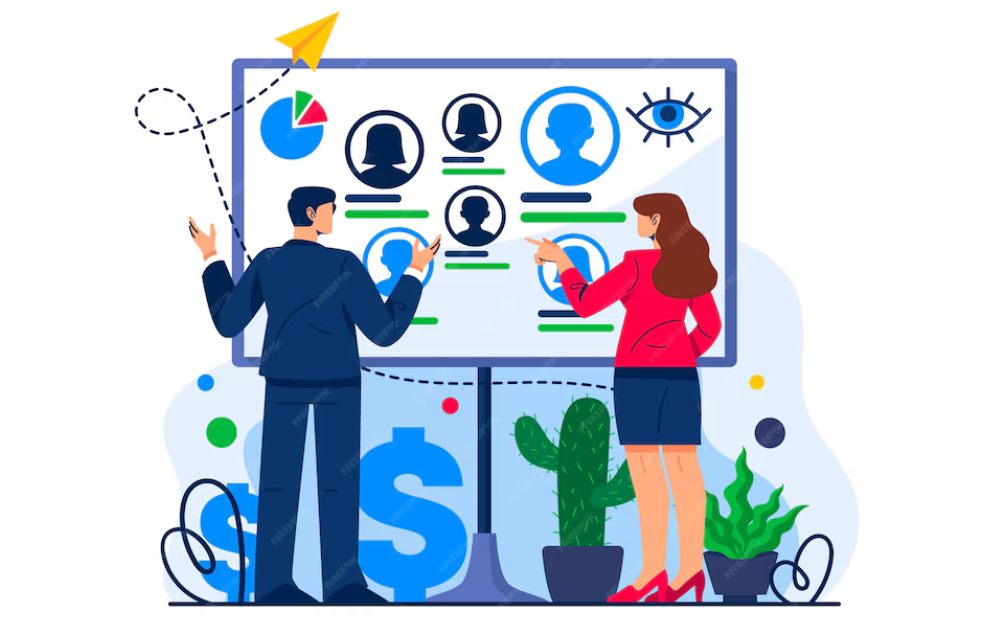
In the dynamic landscape of professional networking and B2B marketing, LinkedIn has emerged as a catalyst for innovation, revolutionizing the way businesses discover and engage with potential prospects. With a user base exceeding 700 million, LinkedIn offers unparalleled opportunities for organizations to forge connections, cultivate partnerships, and drive growth on a global scale. This article explores how LinkedIn’s innovative approach to prospect discovery is reshaping the business landscape, empowering companies to maintain a competitive edge and unlock new avenues of growth. From precision targeting and personalized outreach to thought leadership and data-driven decision-making, LinkedIn continues to redefine the possibilities of prospecting in the digital age.
LinkedIn’s Prospect Revolution: Innovate Business Growth
1. Precision Targeting for Enhanced Outreach

In today’s hyper-competitive business environment, reaching the right audience with the right message at the right time is essential for success. LinkedIn’s sophisticated search and targeting capabilities play a pivotal role in helping businesses achieve this goal.
Sophisticated Search and Targeting:
LinkedIn offers a plethora of advanced search filters that allow businesses to narrow down their target audience with remarkable precision. Companies can filter prospects based on various criteria such as industry, job title, company size, geographical location, and more. This level of granularity enables organizations to tailor their outreach efforts to highly specific segments, increasing the relevance and effectiveness of their messaging.
Refined Audience Segmentation:
By leveraging LinkedIn’s robust targeting features, businesses can segment their audience into distinct cohorts based on their unique characteristics and preferences. Whether targeting decision-makers in Fortune 500 companies or niche professionals in emerging industries, LinkedIn provides the tools necessary to tailor messaging to each segment’s specific needs and interests.
Tailored Message Templates:
One of the key advantages of LinkedIn’s platform is the ability to customize outreach messages using tailored message templates. These templates allow businesses to craft compelling messages that resonate with their target audience, addressing their pain points, challenges, and aspirations directly. By personalizing messages based on the insights gathered through advanced targeting, companies can significantly increase the likelihood of engagement and conversion.
Optimized Engagement Strategies:
LinkedIn’s advanced targeting capabilities empower businesses to deploy highly targeted engagement strategies across various channels, including InMail, Connection Requests, and Sponsored Content. By delivering personalized messages to the right audience at the right time, companies can maximize the impact of their outreach efforts and drive meaningful interactions with prospects.
Measurable Results:
One of the most significant advantages of LinkedIn’s precision targeting is the ability to measure and track the performance of outreach campaigns in real-time. LinkedIn’s analytics dashboard provides valuable insights into key metrics such as open rates, click-through rates, and conversion rates, allowing businesses to assess the effectiveness of their targeting strategies and make data-driven optimizations to improve results over time.
2. Empowering Sales Professionals with LinkedIn Sales Navigator

LinkedIn Sales Navigator is a powerful tool designed to empower sales professionals to enhance their sales efforts on the platform. With its suite of advanced features and capabilities, Sales Navigator enables sales teams to identify, connect with, and nurture potential customers effectively.
Lead Generation Capabilities:
One of the key features of LinkedIn Sales Navigator is its robust lead generation capabilities. Sales professionals can use the platform to identify and target key decision-makers within their target accounts, allowing them to focus their efforts on high-potential prospects. By leveraging Sales Navigator’s advanced search filters and lead recommendations, sales teams can streamline the lead generation process and identify new opportunities for business growth.
Real-Time Insights:
Sales Navigator provides real-time insights into prospect activities and interactions on LinkedIn, allowing sales professionals to stay informed about their prospects’ behavior and preferences. By monitoring prospect engagement, content consumption, and interaction history, sales teams can identify timely opportunities to engage with prospects and tailor their outreach efforts for maximum impact.
Customized Outreach:
Sales Navigator offers a range of tools and features to facilitate personalized outreach to prospects. Sales professionals can use InMail messages, Connection Requests, and InMail credits to engage with prospects directly and initiate meaningful conversations. Additionally, Sales Navigator provides customizable message templates and email tracking capabilities, allowing sales teams to tailor their outreach messages and track engagement metrics to measure the effectiveness of their outreach efforts.
Account Targeting and Monitoring:
Sales Navigator allows sales professionals to create and monitor target accounts, enabling them to stay informed about key developments within their target companies. By tracking account updates, job changes, and company news, sales teams can identify new opportunities for engagement and take proactive steps to nurture relationships with key stakeholders.
Integration with CRM Systems:
Sales Navigator seamlessly integrates with popular CRM systems such as Salesforce, allowing sales professionals to synchronize prospect data, activities, and interactions between Sales Navigator and their CRM platform. This integration streamlines the lead management process and enables sales teams to track prospect engagement across multiple channels, ensuring a seamless and cohesive sales experience.
3. Personalization and Relationship Building

In the realm of prospecting, establishing meaningful connections and fostering lasting relationships are paramount to success. LinkedIn offers a plethora of features and tools designed to facilitate personalized outreach and relationship building, empowering businesses to connect with prospects on a deeper level.
Customized Outreach:
One of the key aspects of effective prospecting is personalized outreach. LinkedIn provides businesses with the ability to tailor their messages and communications to the individual needs and preferences of their prospects. Features such as InMail and Connection Requests enable businesses to reach out to prospects directly, offering personalized messages that resonate with their interests and goals. By taking the time to understand the unique needs of each prospect and crafting tailored messages accordingly, businesses can significantly increase the likelihood of engagement and conversion.
Engagement Opportunities:
LinkedIn offers a variety of engagement opportunities for businesses to interact with prospects and build relationships. From liking and commenting on prospects’ posts to sharing valuable content and participating in industry discussions, businesses can engage with prospects in meaningful ways that add value and establish credibility. By actively engaging with prospects on the platform, businesses can demonstrate their expertise, build trust, and position themselves as trusted advisors within their respective industries.
Relationship Nurturing:
Building relationships takes time and effort, and LinkedIn provides businesses with the tools they need to nurture and maintain these relationships over the long term. Features such as LinkedIn Messaging and InMail enable businesses to stay in touch with prospects, follow up on previous interactions, and provide ongoing support and assistance. Additionally, LinkedIn’s CRM integration allows businesses to track and manage their relationships with prospects, ensuring that no opportunity falls through the cracks.
Content Sharing and Thought Leadership:
LinkedIn’s platform offers businesses a powerful opportunity to establish thought leadership and share valuable insights with their prospects. By regularly publishing articles, sharing industry news, and participating in relevant discussions, businesses can position themselves as experts in their field and attract prospects who are interested in their expertise. Thought leadership content not only helps businesses build credibility and trust with prospects but also keeps them top of mind when prospects are ready to make a purchasing decision.
4. Establishing Thought Leadership through Content Marketing

Content marketing plays a crucial role in establishing thought leadership and building credibility within an industry. LinkedIn provides businesses with a powerful platform to share valuable insights, industry trends, and expert opinions with their target audience, positioning them as trusted advisors and thought leaders in their respective fields.
Valuable Insights Sharing:
LinkedIn’s platform offers businesses the opportunity to share valuable insights and knowledge with their target audience through various content formats, including articles, posts, and videos. By providing valuable and relevant content, businesses can demonstrate their expertise and position themselves as authorities within their industry. Whether sharing best practices, industry trends, or case studies, thought leadership content helps businesses attract prospects who are seeking valuable information and insights.
Thought Leadership Positioning:
Consistent delivery of valuable content helps businesses establish themselves as thought leaders within their industry. By regularly publishing insightful content that addresses the challenges and pain points of their target audience, businesses can build credibility and trust with prospects, positioning themselves as trusted advisors and experts in their field. Thought leadership content not only helps businesses attract prospects but also keeps them engaged and interested in their offerings.
Engagement and Interaction:
LinkedIn’s platform provides businesses with opportunities to engage with their audience and foster meaningful interactions. By sharing thought-provoking content and participating in industry discussions, businesses can stimulate engagement and dialogue with their target audience. Thought leadership content serves as a conversation starter, prompting prospects to engage with businesses and seek further information or assistance.
Brand Building and Awareness:
Thought leadership content plays a crucial role in building brand awareness and visibility within an industry. By consistently delivering valuable insights and expertise, businesses can increase their visibility on LinkedIn and establish their brand as a reputable authority within their niche. Thought leadership content helps businesses stand out from the competition and attract the attention of prospects who are actively seeking guidance and solutions within their industry.
Lead Generation and Conversion:
Thought leadership content serves as a powerful lead generation tool, attracting prospects who are interested in learning more about a business’s offerings. By providing valuable insights and expertise, businesses can capture the interest of prospects and nurture them through the sales funnel. Thought leadership content helps businesses build trust and credibility with prospects, increasing the likelihood of conversion and driving business growth.
5. Leveraging Data for Informed Decision-Making

In today’s data-driven business landscape, leveraging data and analytics is essential for making informed decisions and driving strategic initiatives. LinkedIn offers businesses a wealth of data and insights that can be utilized to assess the effectiveness of their prospecting efforts and optimize their strategies for success.
Comprehensive Analytics Dashboard:
LinkedIn equips businesses with an extensive analytics dashboard, providing insights into crucial metrics like profile views, engagement rates, and conversion rates. By analyzing these metrics, businesses can gain valuable insights into the effectiveness of their prospecting efforts and identify areas for improvement.
Understanding Prospect Behavior:
LinkedIn’s analytics dashboard enables businesses to gain a deeper understanding of prospect behavior and preferences. By tracking metrics such as content engagement, profile views, and connection requests, businesses can identify patterns and trends in prospect behavior, allowing them to tailor their outreach efforts accordingly.
Performance Measurement and Optimization:
LinkedIn’s analytics tools allow businesses to measure the performance of their prospecting campaigns in real-time. By tracking metrics such as click-through rates, conversion rates, and ROI, businesses can assess the effectiveness of their campaigns and make data-driven optimizations to improve results over time.
Identifying High-Value Prospects:
LinkedIn’s data and analytics capabilities enable businesses to identify high-value prospects and prioritize their outreach efforts accordingly. By analyzing factors such as job title, industry, and engagement history, businesses can pinpoint prospects who are most likely to convert and focus their resources on engaging with these individuals.
Predictive Analytics:
LinkedIn’s platform also offers predictive analytics capabilities that allow businesses to forecast future outcomes and trends based on historical data. By leveraging predictive analytics, businesses can anticipate changes in prospect behavior and adjust their strategies accordingly, ensuring that they stay ahead of the curve and remain competitive in their industry.
